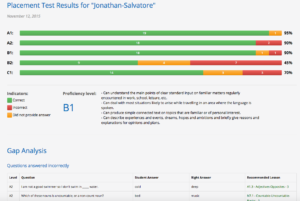{{ post.title }}
{{ post.excerpt }}
Read full storyOne of the weaknesses of other online English Placement Tests…
…is the lack of transparency and the limited information provided to substantiate the level after completion of the test.
An English Placement Test might provide a result of B1. So what? As a teacher, where do you go from there? Which questions were answered by the student? Which questions were skipped by the student? How many questions were answered? What topics were tested? And what about a gap analysis? Without such information, an English placement test is rarely beneficial, except for the most experienced teacher.
Off2Class has now developed a free online English Placement Test for any teacher who wishes to assign it. The test is assigned, completed and submitted entirely online and the results of the Placement Test are available immediately after submission.
How do teachers use English Placement Tests?
Placement Tests are naturally designed more for the benefit of the teacher than for the student. An English Placement Test often provides a starting point for a teacher and student’s educational relationship, and it is especially usefu l when a student returns to ESL studies after a break, in order to highlight the exact topics which require an initial review.
l when a student returns to ESL studies after a break, in order to highlight the exact topics which require an initial review.
Our English Placement Test is designed to provide a Gap Analysis that highlights the student’s areas of weakness in English grammar. The Gap Analysis links the incorrect answers and unanswered question to the Off2Class Lesson Library, which forms a Learning Plan. For Off2Class subscribers, there is immediate access to the lesson plan which will assist to fill in the knowledge gaps.
The feedback about our Placement Test is overwhelmingly positive, but naturally we receive questions that require further explanation. Below are answers to the most common questions regarding our English Placement Test.
It is challenging to provide an answer that will satisfy everyone. However, this complaint appears more often if the student scores lower than expected. A couple of points are worth making here:
In the course of learning a language, a student will cover more than 100 grammar topics, often revisiting those topics at different levels of proficiency. To provide a more accurate Gap Analysis, we have designed a test that covers more than 105 grammar topics across CEFR levels A1 to C1.
This is a test of proficiency, not an opportunity for self-study. With a hundred questions, the student may encounter more than question on the same topic but at different proficiency levels. Hindsight is not a means by which to complete a proficiency test.
Any task that is too hard for a student become quickly demotivating. The test stops automatically if the student selects ‘I don’t know’ seven times consecutively.
If the student answered a minimum of 20 questions, the system will still provide a Proficiency Level and Gap Analysis. If the student answered less than 20 questions, it is not appropriate to provide an assessment of the student’s proficiency.
The English Placement Test examines a student’s abilities across a range of grammar-related questions. It is not designed for a native speaker. It is quite common for non-native speakers to understand grammatical terminology better than native speakers.
We worked hard to build this English Placement Test and we hope that you and your students find it beneficial.
James Heywood
Co-founder, Off2Class
4 Comments
Sebastian Benn says:
May 5, 2020 at 4:26 am
Hi,
If I share my student’s placement test with him, how much of the information will he see? For example, will he see which lessons are recommended?
Many thanks.
Chris says:
May 7, 2020 at 3:47 pm
Yes, the student will see everything that you see!
Anwar Ali says:
December 13, 2023 at 1:20 pm
Could Off2class design a similar diagnostic test for IELTS test takers in the near future? Thanks!
Christine Chan says:
December 20, 2023 at 12:31 pm
Hi Anwar, I’ll submit this comment to our team! In the meantime, you can use this tool for the conversion: https://ielts.org/organisations/ielts-for-organisations/compare-ielts/ielts-and-the-cefr